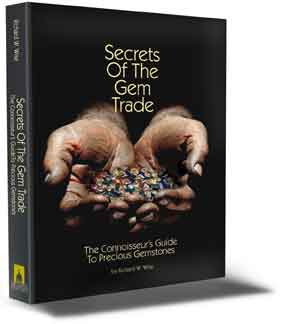

You can’t smell it, you can’t taste it, you can’t see it but its presence or absence can make a difference of tens of thousands of dollars in the price of a tourmaline. What is it? Copper!
By Richard W. Wise
©2007
In late 1990 copper bearing tourmaline from Paraiba first entered the market. In 1991 I wrote an article for Colored Stone “Tourmaline, A Modest Proposal” in which I predicted that just as Paraiba had established a tourmaline aristocracy, inevitably stones that exhibited the light to medium saturation and hue similar to Paraiba stones would escalate in price. What I did not anticipate and could not predict was the discovery of Paraiba-like-copper-bearing- tourmaline in Nigeria and Mozambique. (Pictured above left 0.88 Paraiba tourmaline from Brazil from the R. W. Wise collection.)
Prices have, indeed, escalated and the hierarchy has been established. Regardless of the quality of the stone, genuine Brazilian stones from the Paraiba mining region will bring the highest prices followed by Mozambique followed by Nigeria. (Pictured below right: 14.70 carat pair of pear shaped Mozambique cuprian tourmalines. Cutting Edge Award Winners, sold)  Problem is, areas such as Afghanistan are producing vivid blue green non-cuprian gems that are superior to some of the cuprian stones. What determines the price, beauty, oh no, its all about the copper. We have become inured to such absurdities in the ruby, sapphire and emerald markets but Virgina its only a tourmaline! (pictured below left 3.97 carat Afghan non-copper bearing blue tourmaline from the R. W. Wise Collection)
Problem is, areas such as Afghanistan are producing vivid blue green non-cuprian gems that are superior to some of the cuprian stones. What determines the price, beauty, oh no, its all about the copper. We have become inured to such absurdities in the ruby, sapphire and emerald markets but Virgina its only a tourmaline! (pictured below left 3.97 carat Afghan non-copper bearing blue tourmaline from the R. W. Wise Collection)

So at every booth in Hong Kong showing a pretty blue green tourmaline. What was the first question? “Is it copper bearing?” Without asking that question is was impossible to price the stone.
Staggering Prices Differentials:
Price differentials can be staggering. The 14.70 pair of pear shapes pictured above right are certainly the finest of the Mozambique stones yet they sold at a price that was less than half what a comparable, if you could ever find a comparable, pair of Brazilian Paraiba stones would bring. Stones that compare in beauty but are not copper bearing bring hundreds of dollars while copper bearing look-alikes command prices into the low thousands of dollars per carat.
Whats New on our website:
Still haven’t given up my day job. Just finished uploading a number of new pieces to our online catalogue. Several new tourmalines plus sapphires and some lovely new and antique jewelry pieces. www.rwwise.com
Whats a buyer to do?
Follow me on gem buying adventures in the pearl farms of Tahiti. Visit the gem fields of Australia and Brazil. 120 carefully selected photographs showing examples of the highest quality gems to educate the eye, including the Rockefeller Sapphire and many more of the world’s most famous gems. Consider my book: Secrets Of The Gem Trade, The Connoisseur’s Guide To Precious Gemstones.
educate the eye, including the Rockefeller Sapphire and many more of the world’s most famous gems. Consider my book: Secrets Of The Gem Trade, The Connoisseur’s Guide To Precious Gemstones.
“Wise is a renowned author… He’s
done a marvelous job of this first book, monumental work, a tour de force…My recommendation: Buy this book”.
Charles Lewton-Brain, Orchid
whether you like to know what the best colour is in Tanzanite, or how to grade a Diamond, you will find it in this book. No other book I read before dealt with this topic is such detail as Richard Wise’s masterpiece.”
A. Van Acker, FGA
Amazon June 2005
“Secrets Of The Gem Trade: The Connoisseurs Guide To Precious Gemstones by Richard W. Wise is an impressive new reference for dedicated dealers and collectors of gems, gemstones, and … pearls. Introducing and descriptively exploring each and every gem covered in the easy-to-use reference, Secrets Of The Gem Trade contains an illustrated summary of each stone inclusive of its history and general information, hue and tone, saturation, which may be noticed as the finest, an understanding of the particular gems rarity, and the caution for synthetics and how to depict them, however depending upon the stone there may be description of clarity, color fading, multi-color effect, etc. Secrets Of The Gem Trade is very highly recommended to anyone interested in gemology as a superbly organized, authoritative, comprehensive, and easy-to-follow reference.”
Midwest Book Review
April 2006
Only $37.95. Read a couple of chapters online: www.secretsofthegemtrade.com.
Buy it on Amazon: www.amazon.com






